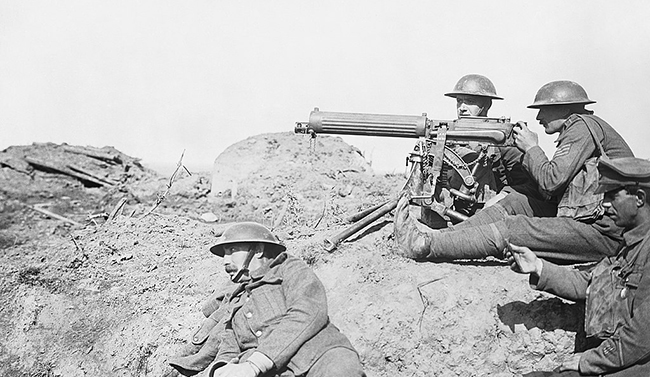Depending upon the gunner and conditions, a barrel modification could be required as often as every 200 to 250 rounds. When the hot barrel was removed, it was set aside till it was cool enough to utilize again. Machine-gun groups would have as numerous as 6 extra barrels on hand.
Driving through a just recently secured location in Belgium, the sharp-eyed Liniewski identified the abandoned weapon in a field. Liniewski then did what any unsupervised GI would have performed in that position; he stopped his truck and seized the chance to snag a terrific memento for the folks back home. As an assistance soldier, Liniewski was not familiar enough with weapons to dismantle his MG-42, so he hung on to it for a while until he discovered a camp where German detainees of war were being held.
The weapon stayed in the Liniewski household till 2016 when his kid Marty donated the weapon to the Museum. In spite of its propensity to get too hot, the MG-42 was an outstanding weapon that was light-years of ahead of the United States equivalent, the Browning M-1919A4 gatling gun. Germany produced roughly 400,000 MG-42s during the war, a few of which are still in active service.

Taken together, all these weapons provided the Red Army a more useful series of support weapons, much better able to challenge the Germans for fire superiority on the battleground. Fully detailed, this research study explains the innovation and the tactics of these device weapons. Kept in mind authority Chris Mc, Nab sets out how these gatling gun were dispersed and tactically used and provides various examples of the weapons in action, from assault teams on the streets of Stalingrad to tank teams having a hard time for survival at Kursk.
Not known Facts About Machine Guns From Canada In The First World War
Illustrated with top quality photos and specially commissioned artwork, this is a deep analysis of these essential tools of warfare within the Soviet forces.
Taken together, all these weapons offered the Red Army a more useful series of assistance weapons, much better able to challenge the Germans for fire supremacy on the battlefield. Fully illustrated, this study describes the innovation and the methods of these maker weapons. Noted authority Chris Mc, Nab sets out how these device guns were distributed and tactically used and provides various examples of the weapons in action, from attack teams on the streets of Stalingrad to tank teams having a hard time for survival at Kursk.
Illustrated with top quality photos and specifically commissioned art work, this is a deep analysis of these necessary tools of warfare within the Soviet forces.
The machine weapon company, commanded by a captain, had an assigned strength of six commissioned officers and 172 employed males, and carried 16 guns, 4 of which were spares. Within the business there were three squadrons and a head office section. A first lieutenant led the very first platoon, while second lieutenants led armies two and three.
Some Known Factual Statements About Russian Machine Guns Of World War I


Within each section were 2 weapon teams, each with one gun and nine men, led by corporals. The weapon squad had one fight cart, pulled by a mule, to transport its weapon and ammo as near the shooting position as enemy fire permitted. From there the teams moved the guns and ammunition forward by hand.
It had just two business, identical to the other machine weapon companies in terms of workers and weapons. Each gun team utilized a special motor automobile to carry its personnel, weapon and devices.
In this role the guns were positioned 300 to 1000 meters to the rear of the front line. When they used their guns because fashion, the machine weapon officers frequently encountered opposition from the rifle business commanders, who chose to have the guns further forward, fearing that their infantrymen would be at risk of roaming low rounds as they advanced under the overhead machine weapon fire.
They quickly discovered that the maker guns were high concern targets for enemy fire, and that it was beneficial to have the guns at some range from the infantry positions. Because enemy gatling gun posed the best risk to the assaulting troops, the maker gun teams made every effort to find the opponent weapons and to focus their fire upon them.
The Facts About Trench Guns Of World War I Revealed
A proportion of the guns was kept back as a reserve under command of the machine weapon officer. 6Machine weapon tactical doctrine determined that in the defense the Hotchkiss guns must just rarely lie within 100 yards of the cutting edge which at least two-thirds of the guns need to be echeloned back through the entire protective position, situated so that adjacent guns would be equally supporting.

7 To discover other features on the see our THE DOUGHBOY CENTER wishes to continually broaden this feature. Additions and talk about these pages may be directed to:.
I was impaled on this. My only worry was that he would press the trigger which would have made a hell of a mess. In the meantime, my sergeant who was near he saw me; came in close; shot the fellow and after that hoisted me, with the aid of another man, off the bayonet.
He was dead and it wasn't enjoyable. A bayonet wound straight it goes in it hurts and the withdrawal is most likely further distress than the 'putting in' because the 'putting in' is immediate. Another type of weapon was the trench club. These might be employed on trench raids and in close quarter combating.